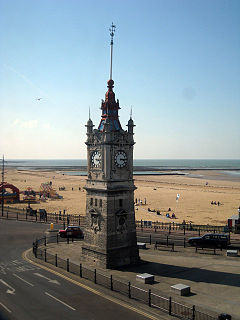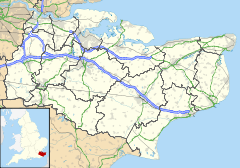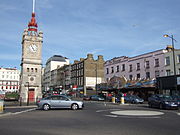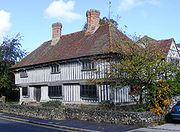
Margate
Did you know...
SOS Children made this Wikipedia selection alongside other schools resources. All children available for child sponsorship from SOS Children are looked after in a family home by the charity. Read more...
Coordinates: 51.3850°N 1.3838°E
| Margate | |
 Margate Clock Tower |
|
|
|
|
| Population | 57,008 |
|---|---|
| OS grid reference | TR355705 |
| - London | 64.1 mi (104 km) W |
| District | Thanet |
| Shire county | Kent |
| Region | South East |
| Country | England |
| Sovereign state | United Kingdom |
| Post town | MARGATE |
| Postcode district | CT9 |
| Dialling code | 01843 |
| Police | Kent |
| Fire | Kent |
| Ambulance | South East Coast |
| EU Parliament | South East England |
| UK Parliament | Thanet North |
|
|
Margate is a seaside town within the Thanet district of East Kent, England. It lies 38.1 miles (61.3 km) east-northeast of Maidstone, along the North Foreland of the coastline of the United Kingdom. Margate's history is closely tied to the sea; it was a "limb" of Dover in the ancient confederation of the Cinque Ports. Margate also consists of Cliftonville, Garlinge, Palm Bay and Westbrook.
History
Margate was recorded as "Meregate" in 1264 and as "Margate" in 1299, but the spelling continued to vary into modern times. The name is thought to refer to a pool gate or gap in a cliff where pools of water are found, often allowing swimmers to jump in. The cliffs of the Isle of Thanet are composed of chalk, a fossil-bearing rock.
The town's history is tied closely to the sea and it has a proud maritime tradition. Margate was a "limb" of Dover in the ancient confederation of the Cinque ports. It was added to the confederation in the 15th century. Margate has been a leading seaside resort for at least 250 years. Like its neighbour Ramsgate, it has been a traditional holiday destination for Londoners drawn to its sandy beaches. Margate had a Victorian pier which was largely destroyed by a storm in 1978.
Like Brighton and Southend, Margate was infamous for gang violence between mods and rockers in the 1960s, and mods and skinheads in the 1980s.
The Thanet Offshore Wind Project was under construction in 2009 and the site is now visible from the seafront.
Government
Since 1983, the Member of Parliament for North Thanet, covering northern Thanet and Herne Bay, has been the Conservative, Roger Gale. At the 2005 General Election, in North Thanet the Conservatives won a majority of 7,634 and 49.6% of the vote. Labour won 32.2% of the vote, Liberal Democrats 14.4% and United Kingdom Independence Party 3.9%.
Margate was incorporated as a municipal borough in 1857. This was abolished in 1974, since which date Margate has been part of the Thanet district of Kent. The town contains the seven electoral wards of Margate Central, Cliftonville West, Cliftonville East, Westbrook, Garlinge, Dane Valley and Salmestone. These wards have seventeen of the fifty six seats on the Thanet District Council. As of the 2007 Local Elections, nine of those seats were held by the Conservatives, seven by Labour and one by an Independent.
Climate
Margate experiences an oceanic climate ( Köppen climate classification Cfb) similar to almost all of the United Kingdom, though its annual precipitation is lower than the national average.
| Climate data for Margate | |||||||||||||
|---|---|---|---|---|---|---|---|---|---|---|---|---|---|
| Month | Jan | Feb | Mar | Apr | May | Jun | Jul | Aug | Sep | Oct | Nov | Dec | Year |
| Average high °C (°F) | 7 (45) |
7 (45) |
10 (50) |
12 (54) |
16 (61) |
19 (66) |
21 (70) |
22 (72) |
19 (66) |
15 (59) |
10 (50) |
8 (46) |
14 (57) |
| Average low °C (°F) | 3 (37) |
2 (36) |
4 (39) |
5 (41) |
8 (46) |
11 (52) |
13 (55) |
14 (57) |
12 (54) |
9 (48) |
6 (43) |
4 (39) |
8 (46) |
| Precipitation mm (inches) | 33.4 (1.315) |
24.8 (0.976) |
23.7 (0.933) |
32.3 (1.272) |
31.7 (1.248) |
32 (1.26) |
33.7 (1.327) |
32.6 (1.283) |
33.4 (1.315) |
53.9 (2.122) |
45.7 (1.799) |
38.2 (1.504) |
415.4 (16.354) |
| Source: | |||||||||||||
Demography
As of the 2001 UK census, Margate had a population of 40,386.
The ethnicity of the town was 97.1% white, 1.0% mixed race, 0.5% black, 0.8% Asian, 0.6% Chinese or other ethnicity.
The place of birth of residents was 94.2% United Kingdom, 0.9% Republic of Ireland, 0.5% Germany, 0.8% other Western Europe countries, 0.7% Africa, 0.6% Eastern Europe, 0.5% Far East, 0.5% South Asia, 0.5% Middle East, 0.4% North America and 0.3% Oceania.
Religion was recorded as 71.6% Christian, 0.7% Muslim, 0.2% Hindu, 0.3% Buddhist, 0.1% Sikh and 0.3% Jewish. 17.1% were recorded as having no religion, 0.3% had an alternative religion and 9.8% didn't state their religion.
For every 100 females, there were 92 males. The age distribution was 6% aged 0–4 years, 16% aged 5–15 years, 5% aged 16–19 years, 31% aged 20–44 years, 23% aged 45–64 years and 19% aged 65 years and over.
11% of Margate residents had some kind of higher or professional qualification, compared to the national average of 20%.
Education
Junior and infant
- Palm Bay Primary School
- Drapers Mills Primary School
- Garlinge Primary School
- Cliftonville Primary School
- Holy Trinity and St John's C of E Primary School
- Salmestone Primary School
- St Gregory's Catholic Primary School
Secondary modern
- Hartsdown Technology College
- St Anthony's School
Special
- Farrow House School
- Laleham Gap School
- Royal School for Deaf Children
- Ursuline College
- Hartsdown School
Grammar
- Chatham House Grammar School - Combined into one school in 2011 (Ramsgate)
- Clarenden House Grammar School - Combined into one school in 2011 (Ramsgate)
- Dane Court Grammar School (Broadstairs)
Economy
As of the 2001 UK census, the economic activity of residents aged 16–74 was 33.8% in full-time employment, 11.8% in part-time employment, 8.0% self-employed, 5.5% unemployed, 2.2% students with jobs, 3.9% students without jobs, 15.5% retired, 8.3% looking after home or family, 7.9% permanently sick or disabled and 3.6% economically inactive for other reasons. The rate of unemployment in the town was considerably higher than the national rate of 3.4%.
The industry of employment of residents was 17% retail, 16% health & social work, 13% manufacturing, 9% construction, 8% real estate, 8% education, 7% transport & communications, 5% public administration, 6% hotels & restaurants, 2% finance, 1% agriculture and 6% other community, social or personal services. Compared to national figures, the town had a relatively high number of workers in the construction, hotels & restaurants and health & social care industries and a relatively low number in real estate and finance.
In more recent years, as tourists have travelled further afield, Margate's unemployment rate has become higher than much of the rest of south eastern England.
Margate railway station, constructed in 1926 to designs by Edwin Maxwell Fry, serves the town. Train services are provided by Southeastern Trains.
Tourism
For at least 250 years, the town has been a leading seaside resort in the UK, drawing Londoners to its beaches, Margate Sands. The bathing machines in use at Margate were described in 1805 as
four-wheeled carriages, covered with canvas, and having at one end of them an umbrella of the same materials which is let down to the surface of the water, so that the bather descending from the machine by a few steps is concealed from the public view, whereby the most refined female is enabled to enjoy the advantages of the sea with the strictest delicacy.
Margate faces major structural redevelopments and large inward investment. Its Dreamland Amusement Park (featured in " The Jolly Boys' Outing" extended episode of the television series Only Fools and Horses) was threatened with closure because of the increase in value of the site. In 2003, one of the arcades on the seafront was destroyed by fire. This has created a new potential entrance point to the Dreamland site. In the following years, 2004–2006 it was announced that Dreamland (although somewhat reduced in its amusements) would reopen for three months of the summer; a pressure group has been formed to keep it in being. The group is anxious to restore the UK's oldest wooden roller coaster,
The Scenic Railway, which is Grade II Listed and the second oldest in the world, and which was severely damaged in a fire on 7 April 2008. It was planned that the Dreamland site will reopen as a heritage amusement park in the near future with the Scenic Railway at the centre. Classic rides from the defunct Southport amusement park have already been shipped in as well as parts of the now-demolished water chute at Rhyl. More details on Dreamland's future can be obtained from the Dreamland Trust website. Today the Dreamland roller coaster is one of only two early-20th century scenic railways still remaining in the UK; the only other surviving UK scenic railway is located in Great Yarmouth and was built in 1932. If the Dreamland Scenic Railway is not rescued the Great Yarmouth coaster would then be the last of its kind in the country. The Margate roller coaster is an ACE Coaster Classic.
Cliftonville, next to Margate, has a classic British Arnold Palmer seaside mini golf course.
A controversial gallery, the Turner Contemporary, has been proposed, as an alternative to Margate's traditional tourist trade, and when built it would have formed part of the harbour itself. Some critics, however, questioned the prudence of placing part of Britain's national art treasures in a spot that is exposed to the full fury of the North Sea. Thanet District Council have now moved the building from the harbour wall, to a plot of land adjacent to the harbour because of the spiralling costs for a sea born building. Construction work on the project has a projected completion of December 2010. The scheme had been supported by the artist Tracey Emin, who was brought up in Margate. It is hoped the gallery will help regenerate the town in the same way St Ives has benefited since the introduction of the Tate Gallery.
There are two notable theatres, the Theatre Royal in Addington Street - the second oldest theatre in the country - and the Tom Thumb Theatre, the second smallest in the country, in addition to the Winter Gardens. The Theatre Royal was built In 1787, burnt in 1829 and remodelled in 1879 giving Margate more national publicity. The exterior is largely from the l9th century.
An annual jazz festival takes place during a weekend in July.
Margate Museum in Market Place explored the town's seaside heritage in a range of exhibits and displays until it was closed in late 2008 when the local authority suddenly withdrew funding to a number of museums.
The Shell Grotto, which has walls and roof covered in elaborate decoration of over four million shells, covering 2,000 square feet (190 m2), in complex patterns, was rediscovered in 1835, but is of unknown age and origin. It has been designated as a grade I listed building.
There is a 16th century 2 storeys timber-framed Tudor house built onto a flint plinth, in King Street.
Twin towns
Margate is twinned with the following towns/cities:




